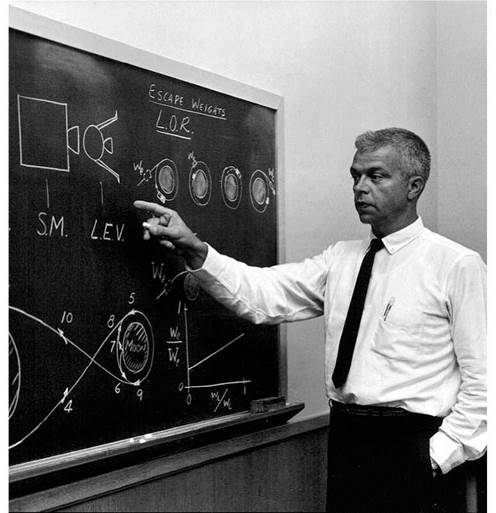1962—THE MODE DECISION FOR APOLLO—JOHN HOUBOLT
At first glance, the method for getting a man on the moon would not appear to have much relevance to the future of manned space stations, but in fact the method that was eventually chosen had a profound effect. The choices were simple enough, and there were three methods to be chosen from: Direct Ascent, Earth Orbit Rendezvous (EOR), or Lunar Orbit Rendezvous (LOR). There were others, but they were mostly far too risky/crazy to even be considered, the most ludicrous being the proposal that one man be launched to the moon where he would wait until such time that NASA figured out how to get him back!
Direct Ascent seemed the simplest of all: launch a giant rocket straight at the moon, without pausing in Earth orbit, land on the moon, and launch straight back to Earth. However, there were drawbacks, first, the rocket would be massive, far larger than the Saturn V that was eventually selected, and its launch facilities would be equally large and demanding. Second, the crew would launch at the top of this massive stack on their backs, as had been the case with Mercury and Gemini, which would mean that they would have to land on the moon in the same way; in other words they would not be able to see where they were landing. Various contraptions were devised to allow the crew (and their instrument panels) to swivel to an upright position for the lunar landing, but none seemed very practical, and of course the instrument panels would have to carry all of the information for lift-off, translunar coast, and landing, which would pose a daunting challenge to design and to operate. Third, imagine backing a vehicle of the size of an Atlas rocket down to the lunar surface; even if you managed it, you would be faced with a trek down a very long ladder to get to the surface.
The most supported mode initially was that of EOR; certainly it was supported strongly by the Marshall Space Flight Center under the directorship of von Braun. Cynics suggested that they supported this mode because it would need several rocket launches, and rockets were, of course, the responsibility of Marshall. This mode basically consisted of two or more launches into Earth orbit, where the moon bound vehicle would be assembled and fueled before setting off for the moon. It had the benefit that all rendezvous operations would take place in Earth orbit, allowing an immediate abort option. The downside was that it was more complicated due to its reliance on multiple launches, orbital rendezvous, dockings, assembly, and refuelling. However, EOR naturally included the option of building a staging post or space station to act as an assembly point for the moon ship; certainly this was favored by von Braun himself. Had this happened, our space station story may have had a very different beginning for NASA.
The third mode option, LOR, was a late comer, being first proposed in I960 by a man named John Houbolt from the Langley Research Center to almost anyone who would listen to him, including all of the potential sub-contractors, and many within NASA. In June 1962 von Braun put his weight behind the LOR plan, and then in July NASA announced that would adopt LOR as the primary option for Project Apollo. It had the advantage that it would require only one launch vehicle which would contain all of the components required for the mission, and NASA chose the Saturn V to serve this role. The downside was that it required a rendezvous and docking in moon orbit where there was no abort option. Also the Lunar Module (LM) only had one ascent engine; if it failed, the crew of two would have a longer stay on the moon’s surface than anticipated. However, the biggest advantage was that it could be implemented much more rapidly than the other two modes, and therefore get men on the moon within Kennedy’s deadline. Nevertheless, LOR left NASA with nothing to build on. Had the challenge from Kennedy not
|
John Houbolt |
arisen, there was a much more logical, albeit slower, way of getting man to the moon.











